




1250 Bellflower Blvd., LA4-203 Long Beach, CA, 90804
Phone (562) 985-8000
El Nicklin
Sam Farfán
Acsah Lemma
Editorial Office Director of Business Operations Managing Editor Editor in Chief Community Engagement Editor
Linsey Towles
Multimedia Managing Editor business@gobeach.media managing@lbcurrent.com eic@lbcurrent.com community@lbcurrent.com multimedia@lbcurrent.com
Kristina Agresta
editors
Juan Calvillo News Editor news@lbcurrent.com
Julia Goldman Arts & Life Editor arts@lbcurrent.com
Joannah Clemente Opinions Editor opinions@lbcurrent.com
Davis Ramage Sports Editor sports@lbcurrent.com
Jaylyn Preslicka Solutions Editor solutions@lbcurrent.com
Mary Catipay Design Editor design@lbcurrent.com
Khoury Williams Copy Editor
Samuel Chacko Photo Editor
Jazmyn De Jesus Social Media Editor
Dante Estrada Video Editor
Aidan Swanepoel Podcast Editor
copy@lbcurrent.com photo@lbcurrent.com socials@lbcurrent.com video@lbcurrent.com podcast@lbcurrent.com
/ LBSU Athletics
The Los Angeles Dodgers celebrate their eighth World Series championship Friday as fans walk the streets of downtown Los Angeles chanting, "Let's go Dodgers."
BY TROY LIPPMAN Contributor
As the upcoming election approaches, students gathered to learn more about their voting rights at the University Student Union on Oct. 28.
The Associated Students Inc. Judiciary Branch hosted the event including several associate panelists who provided attendees information about voter rights.
Topics addressed included access to polling locations and time off work. Students also asked panelists about questions regarding understanding voter rights.
learned more about what she can do as an active voter and said the meeting was very beneficial to her.
“Something I learned was that you can request for your work to give you paid time off so that you are able to go vote, which I found helpful,” Garcia-Guerrero said. “I also learned how you are able to track your ballot.”
Third-year kinesiology major, Dollin Ha said he learned of many voting resources he was unaware of prior to the event.
“One thing I learned was getting two hours of paid time off to vote so that was cool and also about other resources I can use for voting,” Ha said.
Annette Quijada
Mayra Salazar
Opinions Assistants Lizbeth Cortes-Gutierrez News Assistants Ethan Cohen
Grace Lawson Diego Renteria
Romi Mathews
Christine Nader
Sports Assistants Matthew Coleman
Alyssa De La Cruz
Matthew Gomez
Jack Haslett
Soleil Cardenas Design Assistants
Luis Castilla
Timothy Hessen Copy Assistants
Photo Assistants
Bella Garcia
Lauren Benson
Justin Enriquez
Devin Malast
Mark Siquig
Social Media Assistants Matthew Gregory
Andrew Miller
Video Assistants Eduardo Contreras Jr.
Kimberly Perez
Gianna Echeverria Podcast Assistants
Alexandra Gryciuk
One question asked was how to engage students in the voting process. The panelists informed attendees that ASI Lobby Corps had been conducting tablings on campus throughout the last month to educate students about how matters such as policies and propositions affect students and why it is important to have students' voices be heard through voting. Lobby Corps have also held events to discuss topics including the outcome of voting.
Early voting and mail in ballots were also discussed at the event and how it can be more convenient for some people to vote at home by mailing in rather than going in-person to vote.
Katherine Garcia-Guerrero, a sophomore political science and international studies major,
Student voters should choose a voting method that best fits them and their preferences. In order to be registered to vote in the state of California, you must be a citizen of the US and at least 18 years old. California is a same-day voter registration state, however, people are encouraged to register prior to voting at vote.ca.gov.
Long Beach State will have a voting center on campus at the Walter Pyramid starting on Nov. 2 which will allow students to drop off their ballots on campus. It will be open from 10 a.m. to 7 p.m. in the days preceding the election and from 7 a.m. to 8 p.m. on Election Day.
Student voters that work can request paid time off from their employer two days prior to the election providing them two hours to vote on Election Day.
Land acknowLedgment
Here at the Long Beach Current we acknowledge that the school we report on is located on the sacred site of Puvungna, “the gathering place”. We are on the land of the Tongva/Gabrieleño and the Acjachemen/Juaneño Nations who have lived and continue to live here.
We also acknowledge the Gabrieleño/Tongva (pronounced: GABRIEL-EN-YO/TONG – VAH) and Acjachamen/Juaneño (pronounced: AH-HACH-AH-MEN/JUAN-EN-YO) as the traditional custodians of the Los Angeles region along with the Chumash (pronounced: CHOO-MOSH) to the north and west, and the Tataviam (pronounced: TAH-TAH-VEE-YUM) and Cahuilla (pronounced: KAH-WEE-YAH) Nations to the east.
Andrea Contreras Advertising Manager advertising@gobeach.media
Jennix Bien Creative Director
Leila Nuñez Web & Technology Director
web@gobeach.media creative@gobeach.media
Nicollette Combre PR & Marketing Manager
Distribution Manager
assistants advisers
Joseph Vargas
Madison Yang distribution@gobeach.media beach.pr@gobeach.media
Gary Metzker Design Adviser
Barbara Kingsley-Wilson Content Adviser
Jennifer Newton Advertising & Business Adviser
We respect and value the many ways the Tongva/Acjachemen cultural heritage and beliefs continue to have significance to the living people and remind us about the sacred and spiritual relationship that has always existed here at what we now call California State University Long Beach.
editoriaLs: All opinions expressed in the columns, letters and cartoons in the issue are those of the writers or artists. The opinons of the Long Beach Current are expressed only in unsigned editorials and do not necessarily reflect the opinions of the journalism department or the views of all staff members. All such editorials are written by the editorial board of the Long Beach Current.
Monday, Novenber 4, 2024
Letter PoLicy: All letters and emails must bear the phone number of the writer and must be no more than 300 words. The Long Beach Current reserves the right to edit letters for publication in regard to space.
BY CHRISTOPHER CHAN
Contributor
The Dream Success Center’s online information session on Oct. 23 discussed the legal risks for undocumented immigrants who might cast a ballot without the right to do so. Fines and deportation are just a few of the problems.
In collaboration with the Central American Resource Center, a non-profit organization, Dream Success Center’s presentation aimed to inform students about the risks of voting illegally in U.S. elections. It also highlighted the importance of avoiding political petitions and discussed cities that are allowing undocumented immigrants to vote in local elections.
According to the Migration Policy Institute, it is illegal for noncitizens to vote in federal elections in the United States. However, in 16 U.S. regions, noncitizens are permitted to vote in certain local elections.
Nevertheless, as a result of this, a common misconception is that permanent residents believe they are allowed to vote in federal elections. This was something that Office of Legal Access Programs accredited representative, Mitzi Lopez, hoped to address in her presentation to attendees.
“We want to talk about what individuals can expect in the election, but also warn individuals about who can vote,” Lopez said. “I don’t want to say it’s common knowledge because there still are a lot of people who don’t know. The biggest confusion is that even lawful permanent residents are allowed to vote.”
However, apart from Lopez’s sentiments during the presentation, OLAP Accredited Representative David Lawlor emphasized that allowing immigrants to
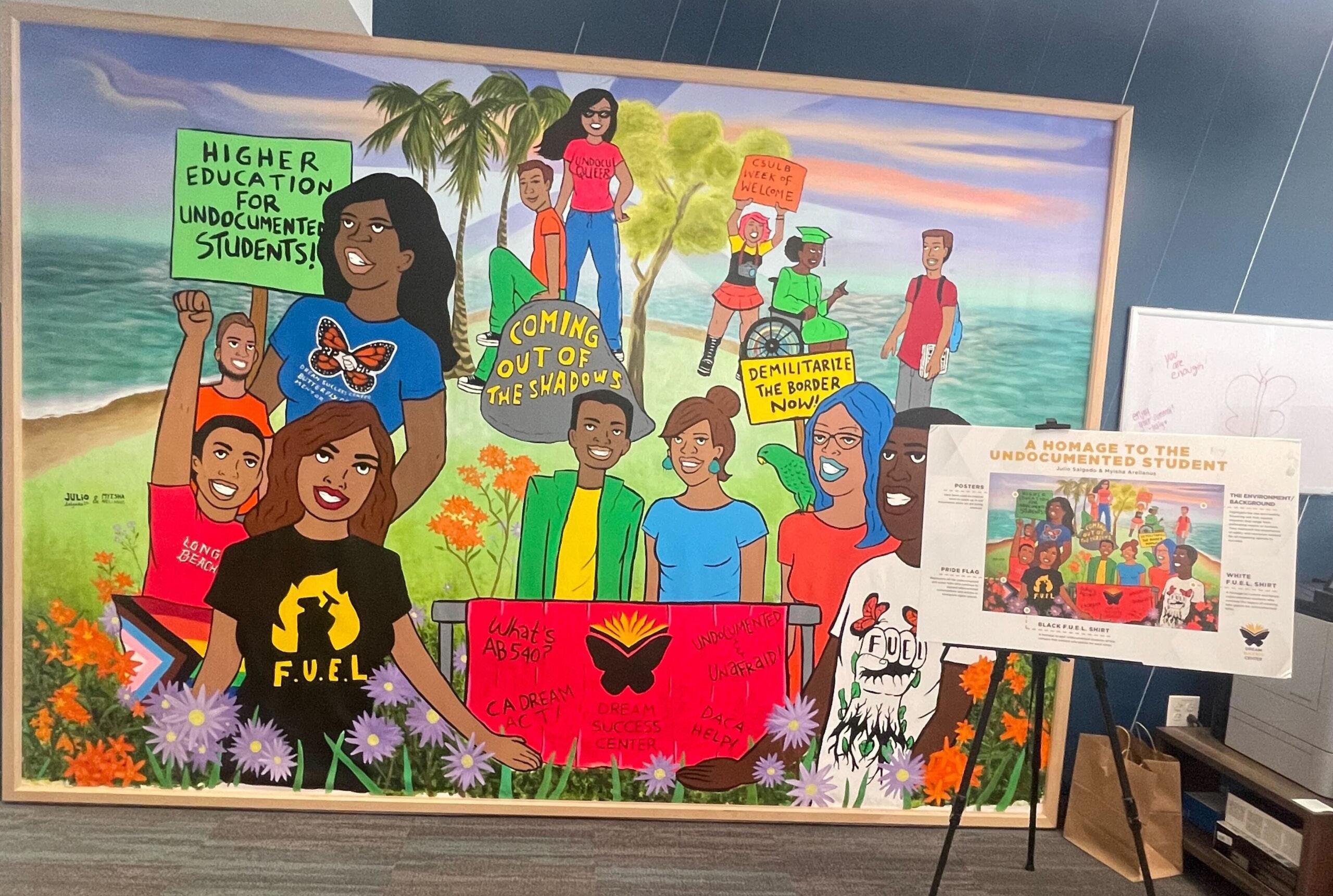
David Lawlor OLAP Accredited Representative ”
Measure DD, a proposal that would allow noncitizens to vote in local elections due to the history of such immigrant participation.
I think it's important because it gives you a say in your community. Voting is the most taken for granted ability, but the most powerful to take.
vote in local elections helps bring communities together. Still, he believes it is unlikely that this will ever extend to federal elections.
“I think it's important because it gives you a say in your community. Voting is the most taken for granted ability, but the most powerful to take,” Lawlor said. “This is just my opinion, but I don't foresee noncitizens voting in federal
elections.”
Some cities in California have introduced the idea of allowing all residents to vote in local elections for the same reasons Lawlor mentioned. Supporters of this concept say that this could help communities come together and have an inclusive decision-making process.
For instance, Santa Ana City Council Member Johnathan Hernandez supports
“For over a century, it was the American principle of 'no taxation without representation'– that if you paid taxes, you’d be able to vote,” Hernandez said. “So, it’s more American for noncitizens to vote in elections than it is for noncitizens to not vote.”
Hernandez's perspective broadens the conversation about voting rights and representation in the United States. However, despite the fact that 24.6% of residents in Long Beach identified as foreign-born, according to the U.S. Census on July 23, 2023, many may not fully understand that current laws prevent noncitizens from voting.
Lawlor and other OLAP representatives believe that information sessions like this are crucial for undocumented immigrant communities to educate individuals on the repercussions surrounding their rights. The next information session is set to take place after the 2024 election.
The 10 propositions on the 2024 election ballot cover issues ranging from rent control to amending the state constitution.
BY JACK HASLETT Sports Assistant
Races at the city, state and presidential level may grab attention during election season, but state propositions on the 2024 ballot have the power to put laws in place that may have the most impact for the individual voter.
Proposition 3 would amend the California Constitution to change the phrasing to match federal rulings on who can marry. Currently, Article 1, Section 7.5 of the California Constitution states that, “only marriage between a man and a woman is valid or recognized in California.” This phrasing contradicts preceding Supreme Court rulings that affirm the right to same-sex marriage.
Proposition 32: Minimum Wage
Proposition 32 would raise the California minimum wage to $18 an hour. California’s current minimum wage is $16 an hour, the third highest in the nation according to a report by Bloomberg Law. An $18 minimum wage would be the highest in the nation if the proposition is approved.
The wage increase would be different depending on business size. Starting in 2025, businesses employing more than 25 people would be required to pay an $18 minimum wage, whereas businesses employing 25 people or less would only be required to pay a $17 wage. The minimum wage would also be adjusted for inflation yearly, beginning in 2027.
Some reasons for opposition to the measure include fears of price increases in small businesses, similar to the price increases seen in fast food after fast food workers’ minimum wage went up to $20 in April 2023.
However, a recent study published by UC Berkeley’s Institute from Labor and Employment found that while fast food menu prices did increase, average menu prices only rose 3.7% compared to the18% increase in income for workers.

Graphic by
The $10 billion requested by the measure would be split up between public K-12 schools and community colleges. Community colleges would receive less but have less requirements on spending than public schools.
Proposition 33 would repeal the Costa-Hawkins Rental Housing Act, a state law limiting the power of local governments to pass rent control laws.
Rent control laws limit how much landlords in a given city or county can increase rent between years, according to the Official California Voter Guide. Currently, Costa-Hawkins prohibits rent control on single-family homes, on any housing development built after Feb. 1, 1995 and generally prevents rent control laws from deciding the original amount of rent a landlord would charge a new tenant.
By repealing Costa-Hawkins, city and county governments would have greater freedom to enact rent control laws without the aforementioned restrictions.
Proposition 4 would authorize the state to sell a $10 billion bond to use as funding in climate and environment focused projects. A bond is a way for the state to borrow money from investors to fund long-term projects. The funding would be divided into several categories covering natural disaster services, energy infrastructure and land conservation. Efforts to combat droughts and wildfires would account for the majority of the $10 billion spending if Proposition 4 is passes. Graphic by Jack Haslett.
Article 1, Section 6 of the California Constitution prohibits slavery, but permits involuntary servitude as a pun-
ishment for crime, meaning incarcerated people in California prisons can be forced to work or be punished for refusing to work. Proposition 6 would introduce an amendment to the California Constitution banning involuntary servitude as a form of punishment. It would also ban California state prisons from punishing inmates who refuse to work.
Currently, the California Constitution requires most cities and county governments to obtain two-thirds local voter approval to approve bonds. Proposition 5 would reduce required voter approval from 67% to 55%. This would only affect monies borrowed used to fund affordable housing construction and public infrastructure projects. Due to a recent addition to the proposition, it also includes a ban on local governments using the borrowed funds to buy existing single-family homes and convert them into affordable units, according to CalMatters.
Proposition 34 would establish new spending rules for health care providers collecting revenue from the Federal Drug Discount Program to direct 98% of their net revenue on patient care services. In addition, they will be required to report their annual revenue to the state in an effort to curb spending by healthcare organizations on lobbying, political donations and acts such as purchasing stadium naming rights, according to the official California Voter Information Guide.
Non-profit clinics and healthcare organizations that receive discounted prescription medication from the program are able to collect revenue by charging private and government-provided health plans more than the cost to acquire the prescriptions.
Opposition to the measure states that it is only on the ballot in an effort to harm the AIDS Healthcare Foundation, who support Prop 33, according to Jerilyn Stapleton, a board member of the National Organization for Women, in a rebuttal of Prop 34 published in the Official California Voter Information Guide.
BY ETHEN COHEN News Assistant
As Americans head to the polls on Nov. 5 to elect the next president, student loan forgiveness has emerged as a critical issue for the more than 40 million Americans who have federal student loan debt.
More than 70% of Long Beach State students and graduates receive financial aid through grants or loans, while the average debt for students following graduation is $16,000, according to a 2023 study conducted by the Cal State Student Association.
Student loans have built up to over $1.7 trillion nation-wide; the attempts by the Biden administration to wipe out large portions of the sum have met resilient opposition, including the Supreme Court striking down plans to forgive over $400 million of debt in a 6-3 decision.
While both presidential candidates push for greater participation from young voters, they take vastly different approaches to the issue. Neither has laid out a specific campaign proposal for how to tackle the crisis if they were to be elected.
During her time as a U.S. Senator from California, Vice President Harris supported several proposals to reduce student debt and offer free education for students. She backed the College For All Act of 2023, introduced by Vermont Senator Bernie Sanders and Representative Pramila Jayapal, amongst a few other proposed bills that ultimately did not get passed into law.
Harris has championed Biden’s student loan forgiveness efforts while holding a similar track record of her own, calling for narrower debt forgiveness during her 2019 presidential campaign–which, at the time, faced criticism for being limited in scope.
Despite the defeat of the Biden administration’s loan forgiveness plan, the administration recently canceled $170
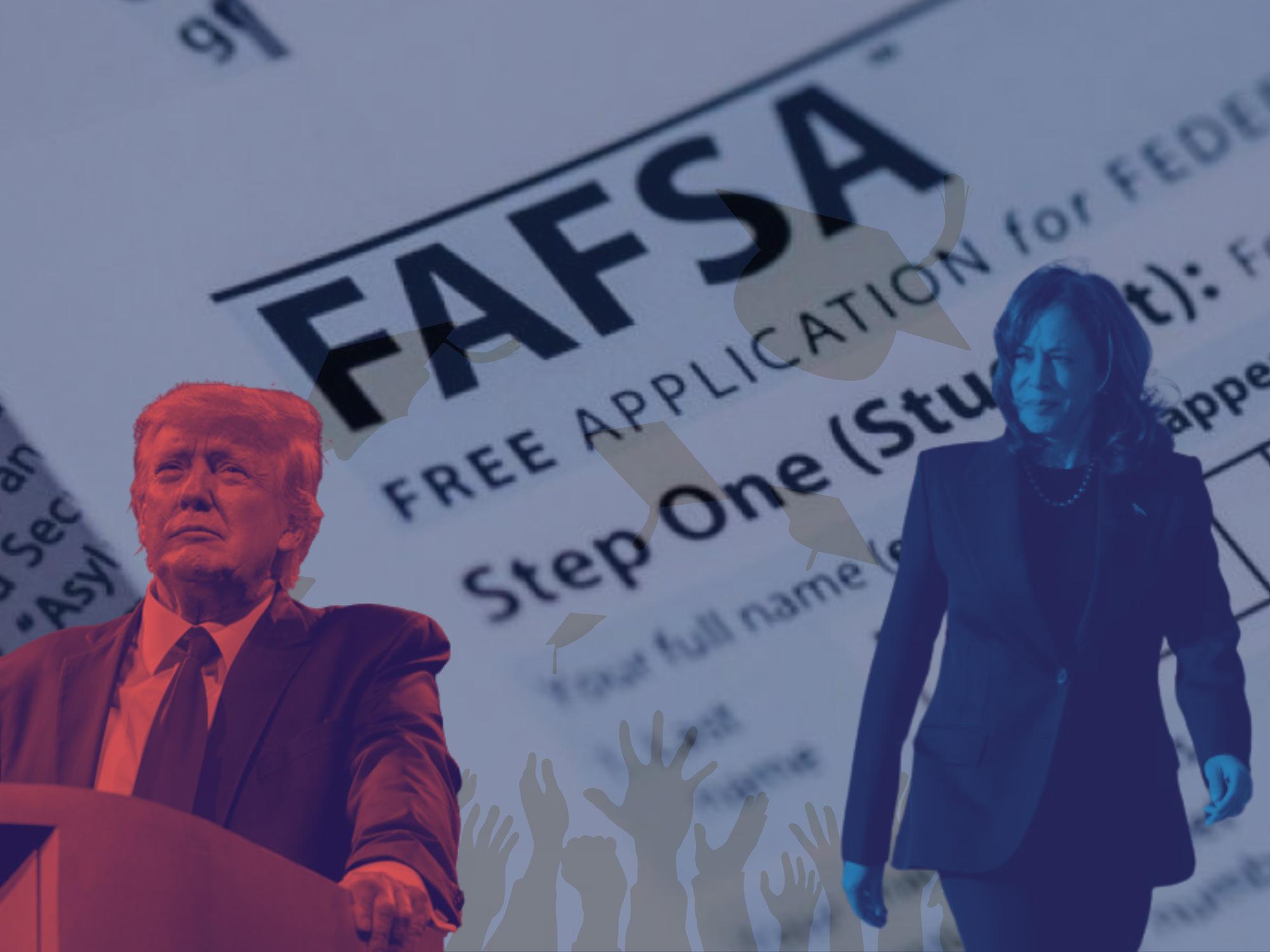
The United States has built up over $1.7 trillion in student loan debt. What student loan forgiveness will look like under each candidate’s presidency is a pressing question for many as election day approaches.
billion in debt for over five million people.
On Harris’ campaign website, she said she will “continue working to end the unreasonable burden of student loan debt and fight to make higher education more affordable, so that college can be a ticket to the middle class.”
However, her campaign team has yet to highlight the specifics of a new forgiveness plan if elected.
In her attempt to court moderate voters, Harris’ campaign has focused on potential voters without college degrees, prioritizing issues they see as vital to this election.
When the Supreme Court struck down the Biden administration’s attempt to cancel a large swath of student debt, former President Trump touted his role in nominating the justices that struck it down, calling it an “unconstitutional student loan gimmick” in a press release from July 2023.
During Trump’s first term, Congress paused student loan payments at the height of the COVID-19 pandemic. Trump later extended the pause on interest accrual and payments on student debt through the end of his term.
Trump’s campaign has largely avoid-
ed discussing this issue for the upcoming 2024 election. However, his website mentions “more affordable alternatives to a traditional four-year college degree” and “fund proven career training programs”.
Vice Presidential nominee JD Vance also highlighted his readiness to spar with the Democratic party over the issue in a post on X from 2022, formerly known as Twitter.
“Forgiving student debt is a massive windfall to the rich, to the college educated and most of all to the corrupt university administrators of America. No bailouts for a corrupt system,” Vance said. “Republicans must fight this with every ounce of our energy and power.”
BY MAYRA SALAZAR News Assistant
Los Angeles County Measure A supports repealing the Measure H tax and replacing it with a 0.50% sales tax to fund homelessness services and an affordable housing ordinance.
In 2017, Measure H was passed, authorizing a 0.25% county sales tax for the next 10 years to fund services and prevention programs for the unhoused.
According to the California Department of Tax and Fee Administration, sales tax doesn’t apply to sales of food products for human consumption.
On Nov. 5, Los Angeles County residents can choose to raise the sales tax created through Measure H on their ballot which will go to fund:
• Homeless prevention services
• Affordable housing
• Mental health treatment
• Addiction treatment Services to children, families, veterans, domestic violence survivors, seniors and disabled people experiencing homelessness
If Measure A is approved by voters, it could raise an estimated $1.1 billion per year to fund homelessness services and programs. Measure A could also create more affordable housing, fund rent relief and provide legal assistance for renters facing eviction.
Measure A would need a majority vote to pass, as opposed to the two-thirds of the votes that Measure H needed to pass in 2017.
At the Supporting Measure A Press Conference on Oct. 21, Los Angeles Mayor Karen Bass said that it is crucial not to lose funding for services and programs, as it can cause Los Angeles’ homelessness problem to increase by 25% in the coming years.
When Measure H expires in 2027, those affected will be cut off from programs and services currently funded by the sales tax.
If approved, Measure A would not have a set expiration date, unlike Measure H, and could be repealed if voters choose to do so in future elections.
Opposers of Measure A say it will double the sales tax increase to pay for failing homelessness programs.

Graphic by ANDREW MILLER / Long Beach Current Measure A is looking to create 0.5% sales tax to alleviate the issue of homelessness, which has been a growing concern for Los Angeles County.
Howard Jarvis Taxpayers Association noted that Measure A will make the tax increase permanent and does not disclose how the money would be used.
Others say that doubling the sales tax would only hurt residents who are struggling with the increasing inflation.
“Money will be taken away from programs or services that do not deliver results,” Bass said during the press confer-
ence. She said that clear outcomes and expectations are written into Measure A.
“Key to this support [on Measure A] of course… is the accountable and transparent use of funds that are built into the measure as part of the leadership we have seen from Mayor Bass and her colleagues,” Nella McOsker, resident and CEO of Central City Association, said in the same press conference.
“Measure A will make sure that thousands of people stay housed. For the first time in years, we have seen a decrease in homelessness, we cannot go backwards, [Measure A] moves people from tents into care,” Bass said.
For more information on the Nov. 5th election, finding your local polling place or voter information, visit the California Secretary of State website.

BY JACK HASLETT Sports Assistant
Measure AC is up for voter approval on the 2024 ballot to allow for a nearly $1 billion bond for construction and renovations in the Long Beach Community College District.
Property owners in the LBCC District would be tasked with paying for the debt that the bond would create if passed.
An annual tax of $25 per every $100,000 of assessed property value, which is the tax value of a property and not the market value, would be put into effect to cover the costs incurred by Measure AC. Both residential and commercial property owners would be included in sharing the costs, according to the Long Beach Community College Foundation.
A full list of the intended improve-
ments has been published by the Long Beach Community College District, which includes a wide array of renovations to classrooms and sports facilities.
Construction of new buildings on both LBCC campuses and the construction of solar panels in certain parking lots on the LBCC Trade, Technical Skills and Community Learning Campus will also be a part of the intended improvements.
The Long Beach Community College District covers Long Beach, Lakewood, Signal Hill, San Pedro and Avalon on Catalina Island. However, there is only one college in the district: Long Beach City College.
The college is split across two campuses: the Liberal Arts campus in Lakewood Village and the Trades, Technology and Community Learning campus in Long Beach.
While there is only one college, each of the cities in the Long Beach Community College District would be eligible to
vote on Measure AC, according to a FAQ form by LBCC.
LBCC recently regained large-school status and hosts over 20,000 students, according to a 2022 report by Data USA.
The development of solar panels would be a part of a broader initiative in the project list to improve energy efficiency on the LBCC campuses. Upgrades to insulation and new installations of energy-saving electrical infrastructure would also be a part of that initiative.
Another main goal for the use of the money is the construction of affordable student housing in the District. The bond resolution details plans to create a “student village” near the Liberal Arts campus in Lakewood Village.
The resolution also includes the possibility of more off-campus housing constructed in collaboration with the City of Long Beach’s “Tiny Homes” program.
A FAQ document from the Long Beach Community College Foundation states the removal of lead paint and as-
bestos from school facilities and improving drinking water systems as necessities that would also be addressed using potential funds from the bond.
Accountability for the funds paid for by the public is baked into Measure AC’s proposal.
If approved, all expenditures would be subject to annual performance audits. Additionally, the district would “appoint and support an independent Citizens’ Oversight Committee” to guarantee the funds are being used appropriately and for their pre-declared intention, according to the bond measure project list.
It is also made explicitly clear in the proposition that the funds are not to be used for any teacher or administrator salaries.
Measure AC is independent from Proposition 2, a state bond measure that would distribute $1.5 billion for renovation and construction to community colleges statewide if passed.
BY ANNETTE QUIJADA News Assistant
Immigration has become an important issue that both Republicans and Democrats want to tackle this election cycle.
Vice President Kamala Harris has said she will focus on securing the borders and fixing the “broken” immigration system if she were elected president of the United States.
She has said her main priority would be to pass the bipartisan border bill that failed to pass earlier this year. The bill would add the following:
• 1,500 new customs and border personnel;
• An additional 4,300 asylum officers to make the asylum process faster;
• Provide funding for an additional 100 immigration judges and staff;
• Provide $1.4 billion for cities and states to expedite work permits for people in the country to qualify.
One aspect that the bill seemingly lacks is how it will assist the Deferred Action for Childhood Arrivals program and whether or not it will create a pathway to citizenship for other undocumented people.
In June, for the anniversary of DACA, Harris released a statement announcing that only Congress can ensure permanent protections and a pathway to citizenship for Dreamers.
Former President Donald Trump maintains an anti-immigration stance, but has made more aggressive promises
on the matter. During a press conference in September, Trump said he wanted to be known as the “border president.” Trump’s immigration plan includes:
• Sealing the border;
• Carrying out the largest deportation operation in American history;
• Stopping the migrant crime epidemic and ‘invasion;’
• Ending birthright citizenship for children of immigrants.
In the past, Trump has said that he supports citizenship for DACA recipients, however, during his first term of presidency he did attempt to end the program.
The California State University system currently has the largest number of undocumented students in any university system in the country with approximately 10,000 undocumented students.
In 2017, the California Values Act (SB 54) was signed into law ensuring that no state and local resources would be used to support federal immigration enforcement and that schools would be on the list of safe spaces for communities.
Undocumented students at Long Beach State are experiencing mixed feelings regarding immigration in the upcoming election.
Cinthya Zyss, 28-year-old senior political science major, had DACA status until last year when she got married and her husband was able to petition for her permanent residency.
“Kicking us out wouldn’t be the solution since immigrants are an integral part of our society, “ Zyss said. “I think that having clear solutions to immigration would allow people to find more

common ground and bridge the gap that we currently have on positions within immigration.”
Zyss said she hopes that the next administration is able to come up with a bipartisan solution that would allow for undocumented people to find pathways to be able to step out of the shadows.
She suggested “finding an appropriate pathway to citizenship within parameters of [U.S. Citizenship and Immigration Services] that allows for immigrants to contribute to taxes and acquire equality within society.”
DACA recipient and marine biology major, Denisse Gonzalez Gutierrez, is in her senior year at CSULB. She said that she feels the upcoming election is chaotic.
“There’s many different views against the immigrant and DACA community I’m a part of. It’s a lot scary to be thinking about,” Gonzalez Gutierrez said.
“If DACA were to end, it would mean I would have no income.”
Gonzalez Gutierrez said that she feels it is upsetting that no one in the Executive Office of the President of the United States has stepped into action since former President Barack Obama first announced the DACA program in 2012.
Undocumented students who attend CSULB can find support at the Dream Success Center. The DSC provides resources including:
Counseling and mental health services; Free immigration legal services; DACA fee assistance; Academic and financial assistance and much more.
CSULB also provides additional resources including online information from organizations, hotlines and off-campus resources.
Kicking us out wouldn’t be the solution since immigrants are an integral part of our society.
Cinthya Zyss Senior political science major ”
BY JD PRESLICKA Solutions Editor
n-campus housing is a transitionary phase for many young adults.
Although confined and sharing a space with roommates, that doesn’t stop students from having sex in residential housing. For this reason, there are resources provided to students to allow them to make informed choices if they do wish to have sex.
One way the university addresses the topic without being explicit is reminding students about safe sex. Among resources like free condoms throughout campus, the one most advertised to students is Student Health Services.
Allison Borwell Insunza is a health education specialist at Student Health Services and works in junction with other sex education resources on campus.
“It’s ok to talk about sex. I encourage you to communicate clearly with all of your sex partners about STI status, as well as your plan to prevent STIs and pregnancy, if that applies,” Insunza said. “If you are unsure of how to start that conversation, you can schedule a oneon-one with a health educator to discuss effective partner communication techniques.”
According to the 2024 National College Health Assessment, information that was provided by Insunza, CSULB students reported 0.2% (6 students) being diagnosed with HIV or AIDS, 1.1% (36 students) being diagnosed with chlamydia and approximately 1% (approx. 22 students) being diagnosed gonorrhea.
In addition to having counselors, physicians and other on-campus health workers educated in safe sex, Student Health Services also hosts “SexTopia,” as well as the Women’s Gender and Sexuality Studies’ event, “Sex Positive” week. These events feature discussions on sex-related topics for students to learn from.
However, while these resources seek to promote safe sex to the campus body, the utilization of the resources ultimately matters most. When moving into dorms, there isn’t a how-to guide on having sex, and there are no official rules on what you are allowed and are not al-
lowed to do.
Unlike typical renting agreements where there are no regulations to when others are allowed over, the dorms differ within their policies. Since they are Long Beach State property, there are certain guidelines that the students must follow regardless of age, including only two non-resident overnight visits a month.
The CSULB 2024-2025 Community Living Guide, the handbook that all on-campus housing students must abide by, does not provide clear guidelines regarding sex.
Executive Director of Housing and Residential Life at CSULB, Corry Colonna, notes that the general consensus among students and residential advisors is that communication is of the utmost importance.
“We do not prohibit consensual sexual activities, however, residents should not be engaging in sexual activity while their roommates are present, whether that be with a partner or by themselves. If roommates are in a relationship, that is obviously a different matter,” Colonna said. “Most of our students live in double rooms and triple rooms, so we ask residents and their roommates to talk through their expectations with one another during their roommate agreements.”
The agreements, Colonna said, can cover topics ranging from cleanliness, to noise and guests.
University rules contain sections regarding visitors, Title IX and mention of STD/HIV testing through the Health and Wellness Department, but no rules about sex. Since the universities’ rules aren’t explicitly listed, students have created their own social rules.
Psychology major Cynthia Carbajal lived in the Beachside dorms her freshman year at CSULB, though now lives off-campus. In her experience living in the dorms, she says there were resources provided, but students main avenue of communication has always been an informal roommate agreement.
“I think a big [social] norm was communicating to your roommates about when you wanted to bring someone over. Usually, you’d want to bring someone over if you knew your roommate was going to be gone for a weekend,” Carbajal said. “I heard from some of my
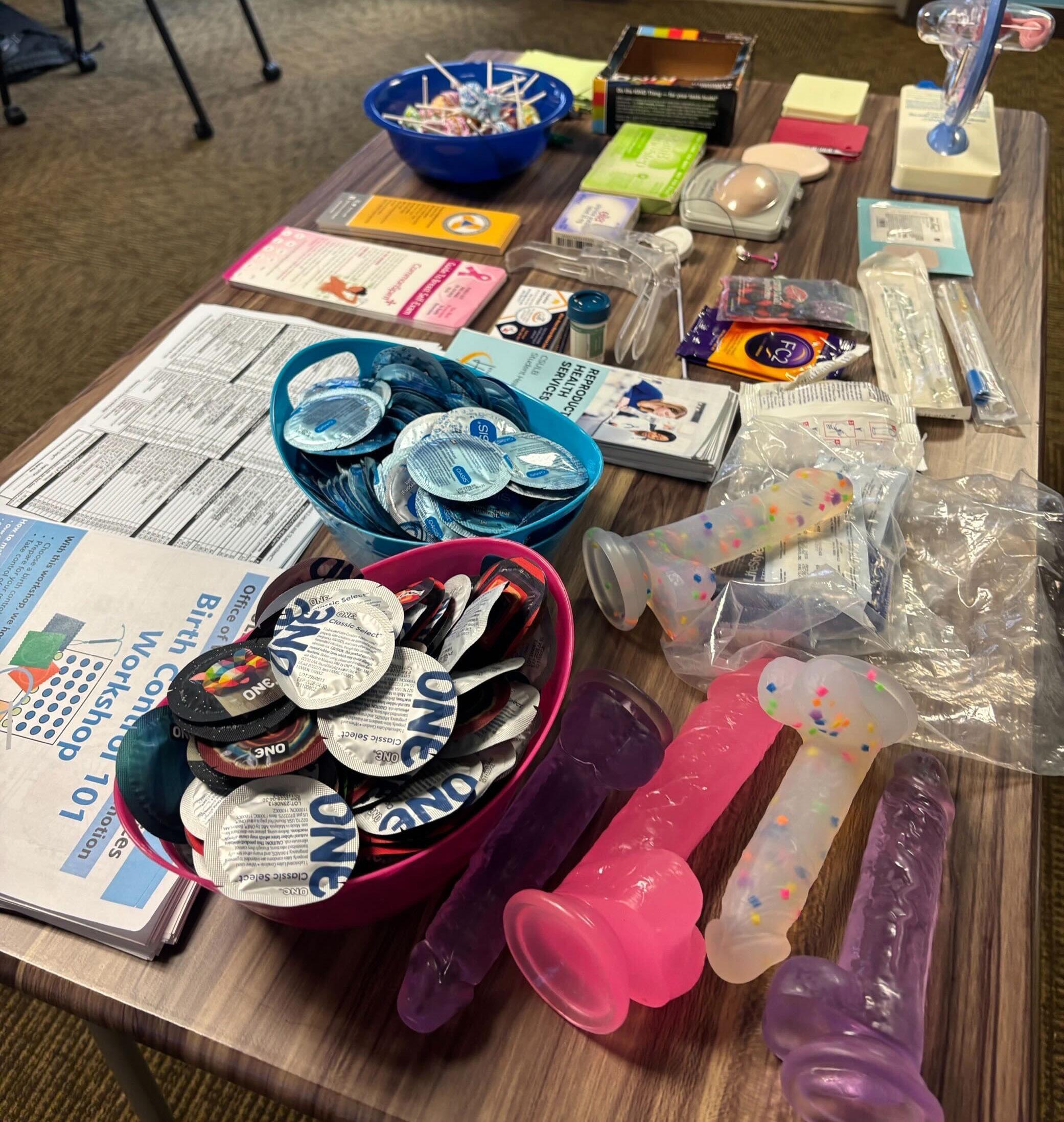
Courtesy of MICHELLE LEON
A birth control seminar hosted in Beachside Village offered condoms, dildos and lollipops for attendees on Oct.18, 2024.
guy friends that it was more common for men to bring someone over to their dorm with no communication beforehand which would make things really awkward.”
The university does acknowledge that students will have sex within the dorms, no matter the restrictions that are placed upon them. For this reason alone, they make the Title IX zero-tolerance policy on sexual assault well known.
When first-year students are set to live in campus housing, they are required to attend a seminar before the first day of the semester titled “Zero Shades of Gray,” an interactive event where students learn about sexual assault and how to approach the topic.
The University Housing and Residential Life page of the CSULB Student Affairs website does link to Title IX, the anti-discrimination and anti-sexual assault
bill every CSU is required to follow. The page does acknowledge that sexual assault can be an issue on campus, and notes, “The first 6 weeks of the academic year is nationally known as the ‘Redzone’ when there is a much higher likelihood of experiencing sexual assault, particularly for first-year students.”
Within the dorms, there are banners reminding students of Title IX and what they can do if a sexual assault does happen within campus housing.
Safe sex is an important aspect of learning how to navigate adult life. During the transitional period of college, resources and information should be learned by students upon experiencing their first steps towards adult life.
Although the culture around sex may have changed, the informal rules of communication and consent will remain a constant.
BY MADISON YANG
Copy Assistant
This Halloween season may have been more nerve-wracking than others, as a fraught race between two drastically different candidates permeates the minds of American citizens.
From a wide range of candidate policies on finances, welfare and LGBTQ+ rights, three young voters at Long Beach State share their values, choices and journeys in staying informed on election topics.
While the California State University student body demographics point toward young adults being the majority, students - including 22-year-old computer science major Peter Som - focus on the bigger picture when choosing the next president.
“I think financial policies have more of an impact [on] the future of our country, so that’s what I try to focus on,” Som said.
As a student juggling multiple parttime jobs while paying hefty tuition prices, Som said he is particularly interested in both candidate’s welfare and tax policies.
Students also research topics that are more closely related to their personal futures, including Lauren Nubla, a 20-yearold psychology major.
As a self-described queer woman, Nubla’s interest in Vice President Kamala Harris is influenced by her support for
LBGTQ+ rights.
She expressed that searching each leader’s policies on LGBTQ+ rights has given her a glimpse into what her life will look like depending on the winning candidate.
“Will I be able to be married? I don’t know,” Nubla said, regarding whether or not the LGBTQ+ community would have rights under another term with former President Donald Trump.
Nubla said she tries to find reliable sources on Google to research the presidential candidates’ views on women’s rights, abortion and immigration policies. She focuses on topics that will impact her circle.
“People I’m close with, if I know that certain policies are going to affect them more than me, then those are things I pay attention to,” Nubla said.
Throughout the year, the Associated Press and Google have recorded the top 10 trending search topics regarding the election per week, with early voting, voter registration and crime being the main topics on Americans' minds as of Oct. 31.
With the country’s alarmingly high rates of crime and homicide, it is not surprising that most voters are focused on what kinds of actions the two candidates will take regarding crime prevention.
According to 23-year-old political science and French major Bailey Brownlee, these statistics are disconcerting and highlight the large influence identities have on what election topics people explore.
Brownlee said he focuses on foreign

Graphic by JAZMYN DE JESUS / Long Beach Current
Researching each presidential candidate is important for choosing the one who best represents your values.
policy when researching election issues, noting that his Jewish background influences his perspective.
“As a Jew, I do pay attention to a lot of attention to the increase in hate crimes,” Brownlee said. “I think that affects the domestic sort of policy I pay attention to.”
Despite a trend in citizens more often obtaining their political news through their tailored social media algorithms, students like Brownlee utilize news out-
lets to learn about the election.
In particular, Brownlee said that he frequents the AP News, NPR, and the two major partisan publications, Fox and CNN, for information about the election.
Amid juggling school work, outside jobs and balancing a college social life, CSULB students, including Brownlee, Nubla and Som, channel their passions into research in order to help shape the future of the country they live in.
People I’m close with, if I know that certain policies are going to affect them more than me, then those are things I pay attention to.
Lauren Nubla Psychology major ”
BY ACSAH LEMMA Editor-in-Chief
The presidential election is just days away and voting has been on the minds of many Long Beach State students. While those registered in Los Angeles county may have had an easier time casting their ballots, students who hail from other cities and states have different experiences.
Sacramento native and third-year mathematics and statistics major Daisy Agebsar said that her ballot still hasn’t come in the mail. Being registered in Sacramento means her mail-in ballot was sent to her family’s address.
Agebsar said she's still waiting on her mother to forward it to her, but being wrapped up in midterms has taken her focus away from the election at hand.
“It’s at the worst possible time,” she said. It isn’t until people mention the election that Agebsar remembers she still needs to vote.
At age 19, this will be Agebsar’s first time voting.
“From what I heard last time, it's a close race," Agebsar said. "Knowing that you have an actual say in comparison to the last election, that's really cool.”
Although this will be her debut into the United States electoral process, Agebsar said that she’s always been aware of current and relevant politics, a byproduct of her parents being immigrants.
“I feel like when your parents are immigrants, it's like they have to be actively listening and looking at policies,” she said.
Discussing stances on political measures is a regular topic of discussion in her family and Agebsar attributes her upbringing in Sacramento to her views on political issues.
“Hearing people that are from Huntington Beach and stuff talking about their experiences, I just appreciate diversity a lot more, and I think that reflects on how I view politics,” she said.
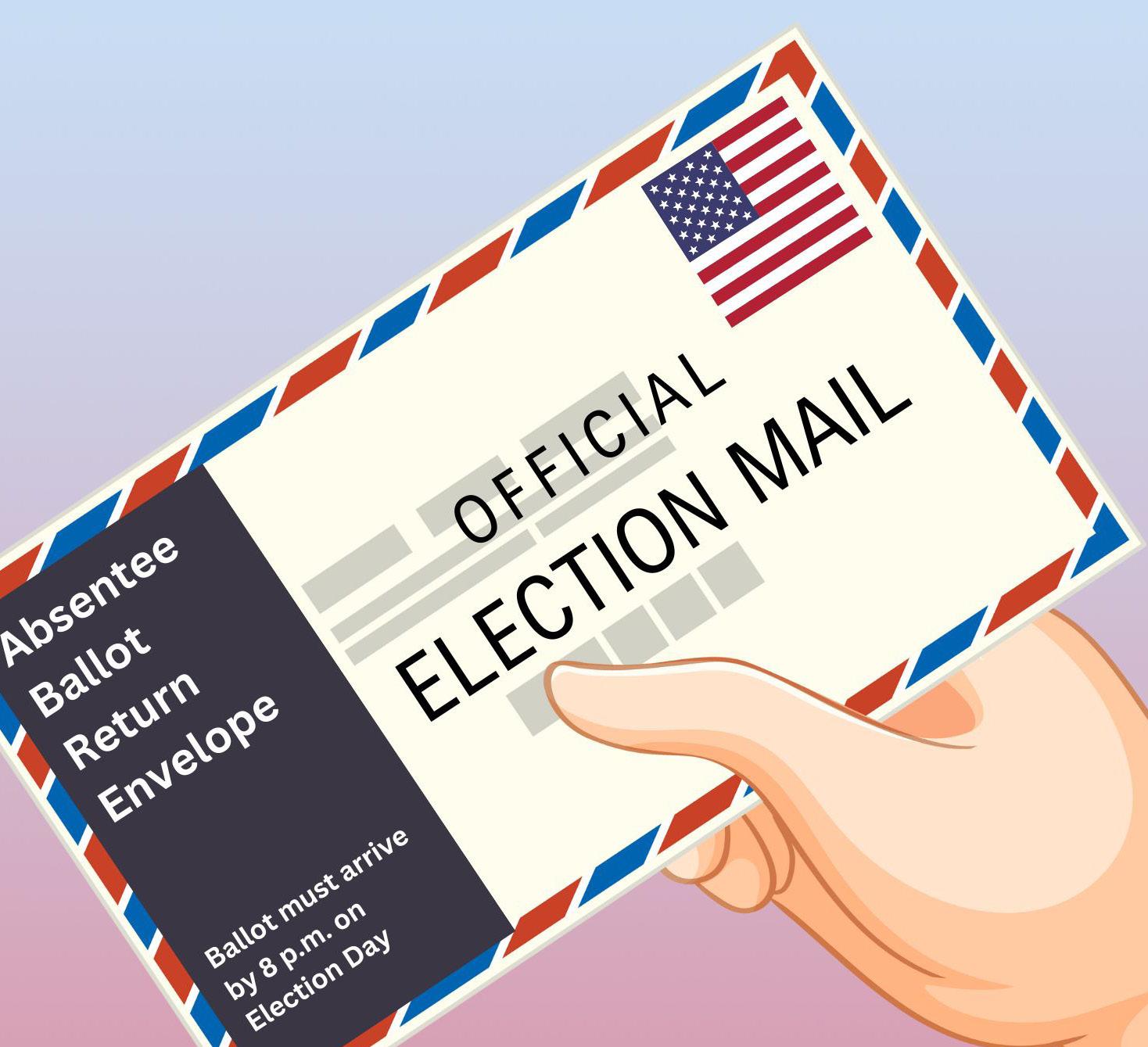
Though the emergence of “identity politics” has been used negatively against the Democrat party, Agebsar said that identity has always been emphasized within society and ingrained in the fabric of this country.
"I don't think at this point is where we flip the script and say identity doesn't matter, given the fact that [identity] has impacted so many policies and rights," Agebsar said. "So I just think that it's important to include your identity when voting… you need your own personal experience to know what you want to change.”
In Agebsar’s case, being a Black woman means that she views this election differently than her peers.
“We’re more at stake,” she said. “So we're at a point where it's like, with the Roe v Wade thing that happened, that proves why we need to be as emotion -
ally attached and why we need to go harder when it comes to voting, especially as women.”
Compared to other CSULB students, Agebsar’s ballot differs slightly. While some students will vote on LA County district attorney or other LA-specific measures, Agebsar’s will have Sacramento measures.
While she is excited to vote regardless, Agebsar said not living in the city you are voting for does make things a bit harder.
“I feel like actually being in the place affects how you vote, sometimes it just wouldn't be as accurate,” she said.
Similar to Agebsar, this election was second-year marine biology major Michael Patrick Mcnamara’s first time voting.
Originally from Madison, Wiscon -
sin, 19-year-old Mcnamara didn’t register to vote until he saw Taylor Swift’s endorsement of Vice President Kamala Harris.
“I always knew I was gonna vote. Honestly, when I saw that I was like, okay, now's the time,” he said.
Swift had posted links to voter registration in her endorsement post, and sitting on his bed Mcnamara completed the steps to becoming a registered voter. His family encouraged him to register in Wisconsin and get an absentee ballot, Mcnamara said, because “Wisconsin is so important in this election.”
A few weeks later, his ballot arrived at his Long Beach address to an eagerly awaiting Mcnamara.
“I took a picture of my ballot. I almost wanted to save it, but then it wouldn't do anything,” he said. “It feels very historic, like either we're getting thrown off the deep end, getting led by this fascist dictator, or we get the first woman president, and that's a big deal.”
Mcnamara said that he is interested, but terrified to see the outcome of the election. While California might not be heavily impacted if Trump is elected president, McNamara said his presidency would be like “giving hate a place to feel welcomed” - something that will ultimately affect everyone.
“Where hate is welcomed, it will invite opportunities for susceptible people to get influenced by that,” he said.
Although Mcnamara commented that it’s pretty obvious who he voted for, he said he believes everyone has got to vote.
“I might not like how you vote, but, I mean, we got to hear what you think,” he said.
To some this election is momentous and to others it’s the same highstakes that it was in 2016. Regardless, Mcnamara said, “We recognize that we are all still people, even if you believe the most heinous sh*t ever… you're still a person and you still want the people of the United States to thrive.”
“Just be accepting,” he said. “Be loving.”
BY ALEX GRYCIUK Podcast Assistant
In 1963, senior generations in government positions believed in the youth to change the world. By creating a more peaceful world, young people would hopefully solve global conflict, climate issues and political violence.
“Children are the world’s most valuable resource and its best hope for the future,” President John F. Kennedy said in an address to the United States Committee for UNICEF.
Unsuccessful, the children of the world failed to fix the planet’s issues.
In 2023, the average global temperature reached its highest level since global records began in 1850. Intense rainfall, extreme droughts and devastating natural disasters, including Hurricane Helene, are the new norm.
Today, over 41,000 Palestinian recorded casualties are the result of conflict in Gaza, and 2.4 billion people face moderate or severe food insecurity globally.
Tragedy and poverty are the new norm.
It’s not young people who are the problem. Refusing to pass the legislative torch while deflecting accountability, the elderly create a stale, gridlocked political environment that stifles positive change.
“The biggest challenge that young people face in politics is the influence of big money interests,” third-year political science major Evan Stein said.
“This can be seen when young candidates for office are completely outspent by their incumbent opponents and when legislation important to young people fails to gain support among career politicians and major political parties who are funded by big lobby groups,” Stein said.
Despite having confidence in young people, older generations resist stepping down from their seats for Millennial (1981-1996) and Gen Z (1997-2012) representatives.
Americans aged 59 to 95 hold 50% of House seats, while Americans aged 27 to 42 hold 12%, according to an article
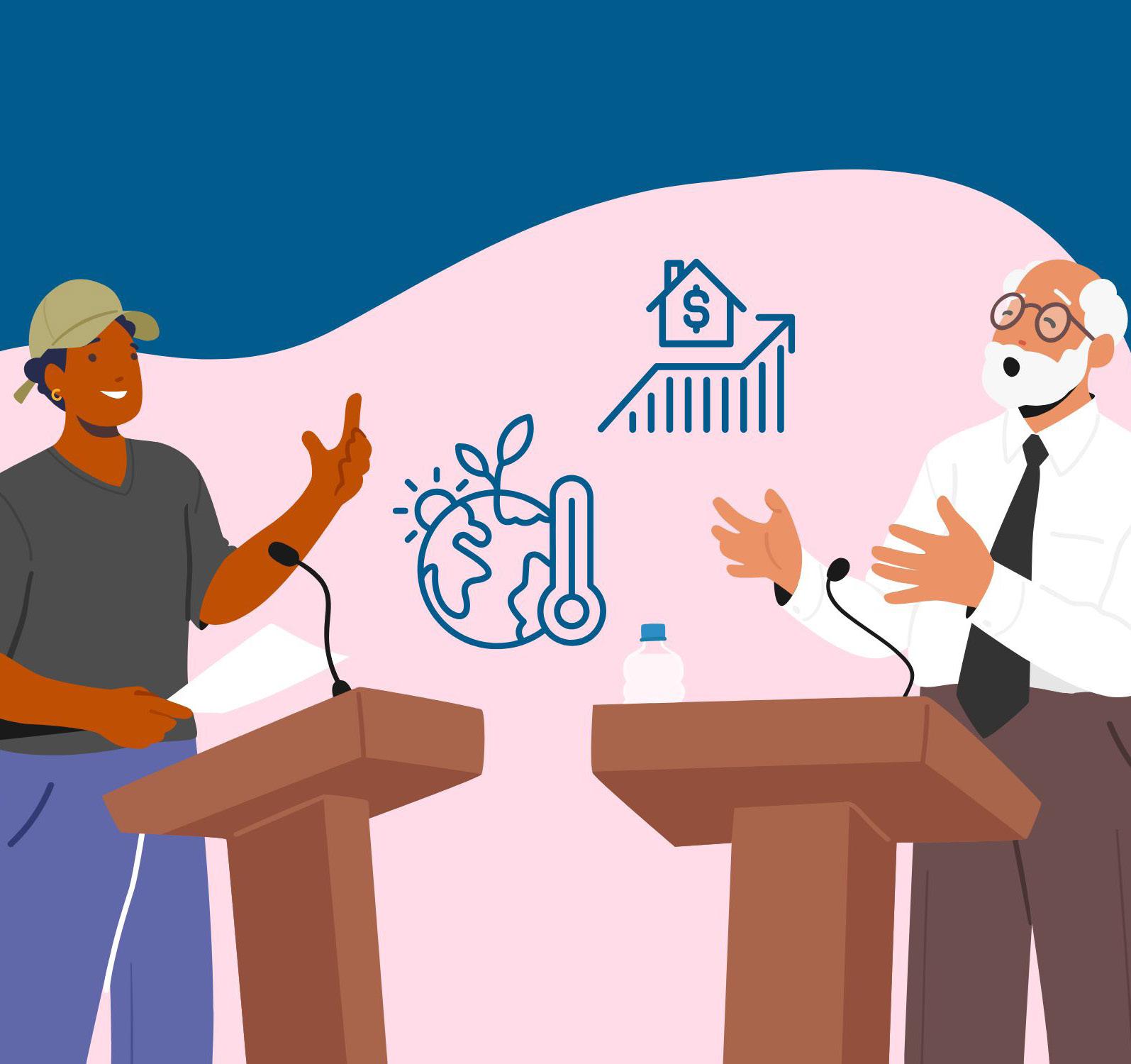
It’s not young people who are the problem. Refusing to pass the legislative torch while deflecting accountability, the elderly create a stale, gridlocked political environment that stifles positive change. ”
from Pew Research Center.
For perspective, the Boomer (19461964) and Silent (1928-1945) generations comprises 26% of the population, while Millennials and Gen Z make up 42% of the population.
“It feels that our generation is not properly represented in Congress,” said third-year marine biology major Carly Brenner.
Having young Congress members reflects the population distribution and national sentiment.
According to the Public Policy Institute of California, Californians older than 55 constitute 50% of likely voters. On the other hand, Californians aged 18 to 34 make up 21% of potential voters.
Since most adults over 55 make up most of the voting population, policies and elected officials will represent outdated ideologies and policies.
Substantial, generational discrepancies between young people and the elderly do exist.
A Pew Research Center survey found that 77% of registered voters aged 18 to 23 disapproved of how Donald Trump handled his job as president. On the contrary, 48% of Baby Boomers and 57% of the Silent Generation approved of Trump’s performance.
Another survey by the Pew Research Center reveals that 70% of Gen Z look to the government to solve problems rather than businesses and individuals.
Only 49% of Boomers and 39% of the Silent generation agree with this ideology.
If young people are set to solve the world’s problems, voters should back up their political beliefs. Voting against their young representatives and largely disagreeing with new policies removes the legitimacy of hope in the youth.
The fact of the matter is, however much confidence one has in the younger generation, there’s little they can do on their own.
To the elderly: put your vote where your mouth is—elect youthful members of Congress and support policies that reflect true public sentiment for positive change.
BY AIDEN REDSTEER
Contributor
With the upcoming election season and Veterans Day on the horizon, many young Americans find themselves questioning their pride in the nation.
A Gallup survey, conducted annually for over 20 years, asked, “How proud are you to be an American?”
In the years following the 9/11 attacks, as many as 91% of Americans reported “extremely proud” or “very proud” to be American.
However, in 2024, that number dropped to 67%, with the lowest figures among those aged 18 to 35, where only 50% expressed similar feelings.
“It’s the actions we do as a country; sometimes they aren’t done well, like the wars we are supporting,” Cesar Climaco, a first-year CSULB student, said. “I am not proud because we are not handling them in a different way.”
Many young people voiced their disagreement with government actions, particularly regarding complex issues like the Israel-Hamas war.
Protests on campuses, including Long Beach State, reflect a growing discontent in the population. Interestingly, similar protests occurred against the U.S. invasion of Afghanistan post-9/11, yet pride levels remained high at that time.
“I think as a nation we are so separated with races, pronouns and genders,” Makenna Campos, a second-year student, said. “We have become separated as a nation, and there is so much hatred.”
This election has illustrated a polarization within the nation. Emotionally charged issues like abortion, immigration, race, gender and wars in the Middle East and Ukraine have progressively set Americans against one another.
This is not a new phenomenon; due

Makenna Campos Second-year student ”
country entails recognizing these shortcomings and actively collaborating with Americans to address them.
I think as a nation we are so separated with races, pronouns and genders. We have become separated as a nation, and there is so much hatred.
to the two-party system of government, most issues tend to be divided on the political stage.
The choice between Democrat or Republican, conservative or liberal, often pushes citizens onto one side of the fence or the other without acknowledging how near the dividing line people stand.
Regardless of the factors that have caused this decline, fostering a sense of American pride remains the top priority,
and the solution lies in cultivating ownership.
Taking pride in one’s work encourages a craftsman to become a master, while pride in one’s child sustains a parent through sleepless nights. Pride is the driving force that fosters dedication in high-performing athletes.
Having pride in one’s country does not mean believing it is without faults; instead, it is the opposite. Pride in one’s
“Even though I don’t agree with some things, I have the right to believe that, and I still have a voice even if people disagree,” Rebecca Torres, a firstyear student, said.
American freedom is frequently discussed; however, the responsibilities that accompany it are even more critical.
While freedom of speech grants individuals the right to express their beliefs, it also imposes upon them the duty to speak truthfully. Freedom of assembly provides the right to protest and the responsibility to support what is just.
“Let us not despair but act. Let us not seek the Republican answer or the Democratic answer but the right answer. Let us not seek to fix the blame for the past, let us accept our own responsibility for the future,” Former President John F. Kennedy said in 1958.
BY JACK HASLETT Sports Assistant
Days spent shooting at targets may sound like a solitary mission, but the Long Beach State Archery Club proves that there is community in such a quiet sport.
According to the club website, the CSULB Archery Club is the longest-running program of its kind. The club features 32 members, including casual archers and a team that competes in tournaments with other collegiate clubs across the nation.
Sophomore physics major Christopher Perez joined the club his freshman year after the club’s display of bows at Week of Welcome caught his eye. As a kid, Perez would shoot arrows in the backyard with his cousin, but club archery was a new level for him. Perez has since thrown himself into the sport and is now team manager during his second year with the club.
“I never expected to be here, the team manager, shooting a brand new bow… and arrows that are made specifically for me,” Perez said. “It’s really exciting to be here and it gives me something to think about other than school. It’s a very nice break from everything that’s going on on the other side of campus.”
The club has proven to cast a wide net. Some approach the club as seasoned archers looking to continue their craft whereas others are discovering the sport for the first time.
Junior film documentary major Abby Kottke, the publicist for the club, has been practicing archery for eight years and the Archery Club even factored into her decision to attend the school.
“It’s a team. You’re gonna go through your highs and your lows, but you’re there together all the way through,” Kottke said. “I like that bond… this is where nothing else matters. All that matters is hitting the target.”

The Long Beach State archery club meets three times a week from 1 p.m. to 4:30 p.m. near the Walter Pyramid. The hours spent together, training at practice and away at tournaments, builds a bond between the team as they work to improve their skills.
The team competed in a qualifier on Oct. 27 at CSULB. The qualifier allows archers to get a score on the record for the season and continue to the championship tournament held in Chula Vista, CA. Scores in tournaments can translate to accolades like All-American designations, a goal for many archers on Long Beach State’s team.
CSULB’s club has seen success, but archery tends to fly under the radar in the shadow of the NCAA-organized sports on campus.
“We are surprisingly really good as a school and people don’t really know that,” said Club President and fourthyear molecular cell biology major Andres Flores. “We won a lot of medals last year. This year, we’ll probably win a
lot of medals... we just kind of win, and then we’re like ‘alright, let’s go back to shooting.’”
While this sport may seem highly individualistic on the surface, community is a major part of archery. The club offers an opportunity for archers to find their niche on a campus that can sometimes be hard to fit into. Archers often find themselves practicing alone, but the club provides an opportunity for individuals to be together.
“I know freshman year, I didn’t feel part of the school,” Flores said. “But then, I found my group and now I’m here. I recommend people… joining a club. Joining clubs is great and a lot of people just don’t do it.”
Prospective members can now join the club right away, whereas previous -
ly, there was a form of tryout or skill assessment for new members. The mix of new and seasoned archers provides a space for collaboration that has impressed head coach Wendy Whalen.
“You can have a beginner shooting right next to an Olympian, and for the most part archers are very generous with their knowledge,” Whalen said. “They’ll share equipment if you have a breakdown. They want the competition, they’re really good with that.”
Whalen got involved with archery as a way to find an activity that her whole family could do together without having to travel across town going between different sports.
Whalen then fell in with coaching a group at El Dorado Park in Long Beach, where she connected with people from the CSULB team looking for someone to coach the team consistently, and Whalen came aboard.
Archery has a long history with LBSU. The program as a whole is spearheaded by Kinesiology Professor Mel Leach, who has led the program as a coach and professor since 1968. Leach teaches archery as a class now, while Whalen coaches the team.
A lack of funding for the club often presents issues in a sport with so many different pieces of equipment. A single archer’s bow can cost hundreds or thousands of dollars depending on the type, and arrows themselves come with individual components like the spine, feathers and point.
While the archery team has coaches to instruct the archers, the club is run by a board of students that includes Flores, Kottke and Perez.
Whalen sees her role as the consistent figure who is there to pass on knowledge as student leaders inevitably graduate.
“I’m only there to help them shoot better, and give them tips and pointers,” Whalen said. “They’re all students… they’re only here for a short amount of time. Sometimes that knowledge doesn’t get passed down. The coaches make sure we’re backing them up.”
BY MATTHEW COLEMAN
Sports Assistant
Two minutes and thirty seconds. That’s how long LBSU women’s basketball’s redshirt sophomore forward Kennan Ka’s 2023-24 season lasted before tearing her anterior cruciate ligament lateral meniscus and medial collateral ligament in the first quarter of the season’s first game.
After playing in all 33 games in her freshman campaign and being an integral part of The Beach’s 17-3 record in Big West play that secured the regular-season conference title, Ka was poised to take a jump on the court with her game and off the court as a leader.
Ka got the start in the season opener against Biola, even recording the team’s first field goal and rebound before her season was cut short in a gruesome fashion.
“To be honest, I think I was in denial for a while. I didn’t believe it,” Ka said. “Going into that game, I felt like I was in the best shape of my life, I felt like I was playing really good basketball.”
The magnitude of Ka’s injury was unknown originally. It was later discovered that her MCL had suffered unique structural damage, which indicated it was almost detached from both sides of the bone.
“It really just affected my daily life; it was hard to have a sense of independence,” Ka said. “I really couldn’t walk or put weight on it, I was locked straight in a knee brace for around two months, on crutches for two more months.”
Routine day-to-day tasks became a struggle for Ka, as grappling with her new, uncharted reality became a hard truth to accept.
“Getting on the couch, I had to have a band in order to lift my leg up or to drive. It would take me five minutes to back my seat up all the way,” Ka said. “Little things that you take for granted were just challenging.”

With significant obstacles on the horizon, Ka soon realized the mental and physical strength required to make a full recovery to get back onto the court.
Ka credits her “unbelievable support system” of coaches, teammates, family and friends from her home in San Diego, who supported her in the ways she needed during her road back to rehabilitation.
“I had a great team of physical therapists, chiropractors and doctors all behind me,” Ka said. “I think Long Beach [State] just [offers] a lot of support and
services off campus that helped me progress.”
Ka said her former strength coach, Uri Lopez, had an immense impact on her over the past year. She acknowledges him for being in her corner throughout the recovery process.
“He would always be checking in on me, constantly supporting me. He would write up workouts that I could do,” Ka said. “Also, just on the mental side, he was always there for me.”
With the new season approaching, Ka has been medically cleared and is on
schedule to return to action for LBSU’s first exhibition game on Wednesday, Nov. 6. against Cal State LA at the Walter Pyramid before the regular season gets underway three days later against William & Mary.
Ka’s return to the court will come exactly 364 days after the career-threatening injury sidelined her.
“It’s totally changed my perspective to never take a day for granted,” Ka said. “Every time I lace up my shoes now I just take a moment of gratitude that I can play a sport where I can move my body.”
BY ALYSSA DE LA CRUZ & JUNIOR CONTRERAS Sports Assistant & Contributor
Clockwise from right: Fans begin to exit the parade route at Grand and 5th after the Dodgers’ championship celebration, navigating the bustling streets filled with excitement and heavy congestion at 12:15 p.m. A dedicated Dodgers fan climbs a pole, proudly displaying a sign that reads, “I’m naming my daughter Freddie Freeman,” honoring the star first baseman’s key role in the team’s 2024 championship win. President of Baseball Operations of the Los Angeles Dodgers Andrew Friedman (left) holds the Commissioner’s Trophy high during the city’s first Dodgers parade since 1988. Baseball manager Dave Roberts (right) and the Dodgers team revel in their 2024 World Championship victory as they parade through downtown Los Angeles.
Photos by MATTHEW MEDINA
LBSU Athletics


LOS ANGELES — A long-held day for Dodgers fans as transformed into a vibrant Thousands gathered victory over the New York both an eighth championship to LA for the first time since 1988.
The celebration marked more than moment to honor recent and long-standing paid tribute to Dodgers legend Fernando died on Oct. 22.
The Nov. 1 parade, held on what Valenzuela’s 64th birthday, echoed the domania” era– now woven into the team’s
“This one was for him,” die-hard Dodgers said. “I know he is smiling down on us
Chants of “Let’s Go Dodgers!” and filled the air as fans celebrated this long-anticipated
The atmosphere was electric as fans waving flags and cheering while players sioner’s Trophy aloft. The parade of LA’s most iconic streets, with fans “Dodgers!”, “This is Our Town” and “LA
Fans also held signs about specific as Freddie Freeman, the World Series
Valentina Enriquez, a fourth-year Long Beach State, said that this year, the passion that it brought everyone together never before.
She also pointed to Freddie Freeman’s

long-held wish came true todowntown Los Angeles vibrant sea of blue and white.
to honor the Dodgers’ York Yankees, bringing championship and a parade back than just a win — it was a long-standing triumphs as fans Fernando Valenzuela, who
what would have been the legacy of his “Fernanteam’s renewed success.
Dodgers fan Nick Ochoa us today.” and “This is for Fernando!” long-anticipated moment. fans lined near City Hall, players held the Commiswound through some fans holding signs saying, “LA Bleeds Blue.” specific Dodgers players, such MVP. fourth-year kinesiology student at the players had so much together for the parade like
Freeman’s grand slam in
Game 1 of the series as a moment that “solidified the Dodgers’ World Series win” in her heart.
“My first parade was amazing and I know it is not going to be the last,” Enriquez said. “There was a sea of blue wherever you turned, and I kept getting the chills from how happy I was to be there.”
Among the crowd was lifelong Dodgers fan Mike Redston, who flew down from San Francisco for the event.
Right after the win and celebrating, Redston booked his flight and said that even his neighbor hit the ceiling, signaling for him to quiet down from excitement.
When Redston was in LA to celebrate, he felt right at home and loved seeing blue and white all around him.
“Living in San Francisco, I’m constantly surrounded by Giants fans, so this is my way of celebrating with my people” Redston said. “Dodgers are the best, and you’re gonna have to deal with it for a lot more years because they’re gonna win a lot more.”
Chris Farmer, a Dodgers fan from Echo Park, echoed this relief of being able to celebrate a parade in style.
“2020 was special, but this win is on another level. It’s a real championship and a true Dodgers celebration!” Farmer said.
Farmer described his neighborhood’s spontaneous celebration after the series win, sharing how fans took to the streets like never before.
“We’re out here, shooting off fireworks, chanting Dodgers slogans and we finally get to call this championship ours,” he said.
“Go Dodgers, baby,” Farmer said.

Zayna Meyer’s big night not enough as Long Beach State drops third straight, falling 3-2 to UC Riverside.
BY MATTHEW COLEMAN
Sports Assistant
Long Beach State’s recurring trend reappeared Friday night at the Walter Pyramid as they fell to UC Riverside in a five set thriller. The Beach has now dropped three in a row and four of its last five matches, losing in five sets each time.
“It’s taken a toll, the group’s tired, rightfully so. They’ve been playing a lot of volleyball,” interim head coach Natalie Reagan said. “We’re at the end of our rope of being able to tolerate fifth sets.”
The Beach had an opportunity to win the match with one more point, being up 14-12 in the fifth set, but ultimately fell to the Highlanders 16-14.
This marks the first time UCR has beat LBSU since 2021.
“We couldn’t close. We had match point and opportunities to play better volleyball and didn’t,” Reagan said. “That’s all something we are taking very hard.”
From the opening set, LBSU had no answer for UCR’s sophomore right side Trinity Sheridan who finished with a season and game high 31 kills.
The Beach managed to go on a 5-0 run while down 21-20 in the first set to storm back and take set one by a score of 25-21. Redshirt senior outside hitter Abby Karich had five of her team-high 14 kills in the come from behind effort.
The Highlanders responded accordingly in set two, by narrowly edging The Beach by two points to even the match at one apiece, winning 25-23.
Throughout the night, UCR thrived off the energy they brought internally playing with more passion and emotion, it showed in the third set as a 4-0 run after being tied shifted the momentum.
The Highlander bench and Sandpit student section had a back-and-forth dynamic that featured loud noise as both
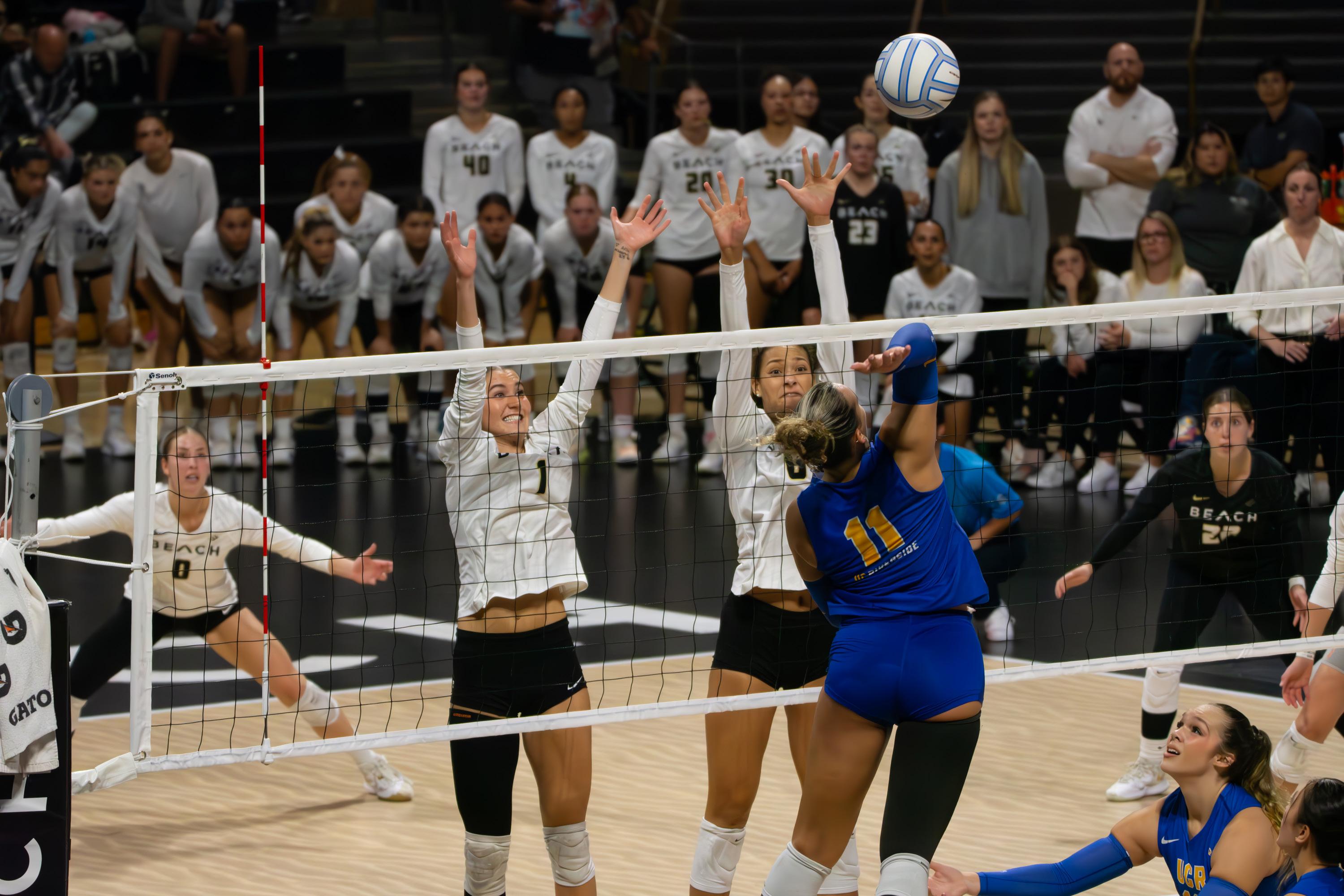
LBSU senior Zayna Meyer (left) and senior Kameron Bacon (Right) attempt to block UCR on Nov. 1 at Walter
UCR ended up defeating LBSU 3-2 in the game Friday night.
teams served.
After being swept by LBSU on their home court in late September, it was evident that UCR was thriving simply of remaining in contention, giving them the much needed spark to eventually take set three 25-20.
LBSU responded with their best set of the night to force a decisive fifth set.
Senior setter Zayna Meyer recorded a season-high 52 assists along with a season-high 19 digs on the defensive end.
Meyer and senior outside hitter Natalie Glenn both recorded double-doubles. Glenn posting 13 kills and 18 digs.
The Beach went on to take set four 25-14, recapturing the momentum and reengaging the Walter Pyramid crowd.
The fifth set presented a variety of emotions on both sides, but ultimately finishing with The Beach on the wrong side of things again. The set featured 11 ties and six lead changes.
Midway through, UCR’s junior setter Makena Tong went down with a severe ankle injury that left her in tears as she was carried off the floor by her teammates.
UCR erased the two-point deficit with their backs against the wall and came out
with the win, storming the floor following an attack error by Karich. During the postgame celebration, tears conceded as teammates embraced Tong who was now on crutches.
The Beach cannot afford to dwell too long about the match slipping away, as their next match is slated for Saturday afternoon against UC Davis back at the Pyramid.
“I wouldn’t say forgetting about it [Friday’s match], but moving on because we have a new match and a new day. We can learn from this but not dwell on it,” Glenn said.